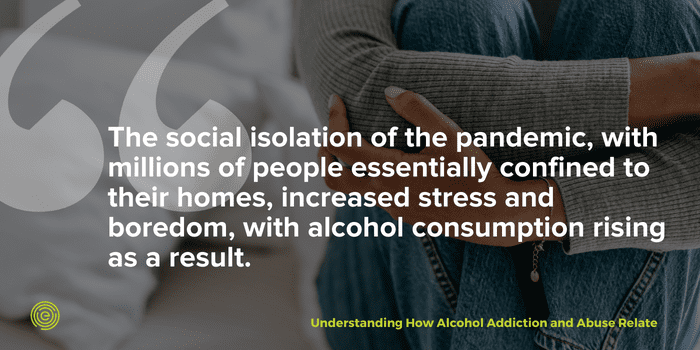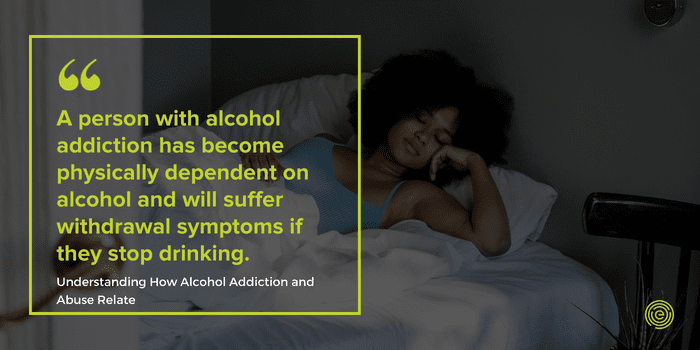Understanding how alcohol impacts your body and mind can also help us understand why it is addictive and how it can come to be abused.
While you might think that alcohol is a stimulant because of the way it can make you relax, it is actually a depressant. Alcohol is a drug that affects the central nervous system by slowing down brain activity and hindering the messages that flow from your brain to your body and back again. That slowing effect can manifest in many ways, including loss of self-control and loss of physical coordination. Alcohol can also cause mental health symptoms, including changes in mood, inability to think clearly or efficiently, and problems with memory.
In addition, alcohol can affect various organs in your body. It raises your heart rate and blood pressure, and it affects your digestive system so you end up vomiting if you drink too much.
The ability to handle alcohol in a healthy and responsible way has a hereditary component, with some people more prone to alcoholism than others. For some people, abstinence from alcohol may be the best way to avoid alcohol use disorder. Understanding alcohol and being aware of the signs of alcohol use disorder is key to taking control of your drinking and dealing with any addiction or dependency.
Alcohol Addiction in Canada
As of 2021, about 21 million people, or about 66% of Canadians, reported having an alcoholic drink in the previous 30 days, according to Statistics Canada. About 63% of these people were able to limit their drinking to one or two drinks a day. The average alcohol consumption in Canada is 8.1 liters per year.
However, 18% of these people drank to excess, consuming at least five drinks in one day, about the equivalent of one bottle of wine. This alcohol consumption was significantly higher than the numbers tallied in 2017 (notably, before the COVID-19 pandemic) when only 11% of Canadians drank five or more drinks in one day. But it’s even higher than the World Health Organization study that showed that 16% of drinkers indulge in binge drinking. The social isolation of the pandemic, with millions of people essentially confined to their homes, increased stress and boredom, with alcohol consumption rising as a result.

That 18% number shows up again in a 2019 study that revealed the number of women of reproductive age drinking more than recommended in Canada’s Low-Risk Alcohol Drinking Guidelines. Women who smoked either tobacco or cannabis showed a higher tendency to drink heavily.
How Long Does Alcohol Stay in the Body?
When you take a drink, the alcohol travels first to your stomach, where about 20% of each drink is absorbed into your bloodstream. The remaining 80% travels to your small intestine and then into your bloodstream. This whole process happens quickly, with alcohol reaching peak levels within 60 to 90 minutes.
Eventually, your drink ends up in the liver, which metabolizes the alcohol at a rate of about 1 ounce per hour. If you drink faster than that, the alcohol accumulates elsewhere in your body, staying in your system while it waits for its chance at your liver. Repeating this behavior too often can cause damage to your brain and other tissues.
Alcohol can take anywhere from 6 to 72 hours to leave your system, depending on your metabolism and, especially, on how much you’ve drunk. Alcohol can be detected in your blood for about 6 to 12 hours and on your breath for up to 24 hours. While sophisticated urine tests can detect alcohol for up to 72 hours, most traditional urine alcohol tests capture alcohol for up to about 12 hours. Alcohol shows up in the saliva for up to 24 hours and in the hair for up to 90 days.
The more you drink, the longer it takes your body to metabolize the alcohol — and the strength of the drink matters, too. Count it taking 60 to 90 minutes to metabolize one can or bottle of beer, one glass of wine, or one shot of liquor. Other factors that play a role in the metabolism of alcohol include your sex (men process alcohol more quickly than women), your body size, your age, the medications you’re taking and the presence of various health conditions.
Short-term Effects of Alcohol
Just one drink can put you in touch with the short-term effects of alcohol, as you start to relax. You may also notice that your reflexes are a bit off, your reaction time is slow, and your behavior is more uninhibited.
As you drink more, the short-term effects, including the social effects of alcohol, magnify. Some people are genetically disposed to have a higher tolerance for alcohol, while others feel these effects more strongly. The effects of alcoholism and of short-term alcohol use also become more pronounced with age and vary depending on how much you’ve eaten and how hydrated you are.
Alcohol can have short-term effects on both your body and your brain. Among the physical effects are:
- Slurred speech
- Anemia
- Unconsciousness
- Dizziness
- Slowed breathing
- Loss of coordination
- Drowsiness
- Diarrhea
- Headaches
- Distorted hearing and vision
- Nausea and vomiting
- Impaired sexual performance
- Coma
Alcohol’s short-term effects on your brain include:
- Decreased perception
- Reduced inhibitions
- Impaired judgment
- Impaired impulse control
- Memory loss (including blackouts)
- Depression and suicidal ideation
- Unstable emotions
- Alcohol-induced psychosis
- Aggression
- Mood swings
- Agitation
What Are the Long-term Effects of Alcohol?
The longer you drink, the higher tolerance you’re likely to develop to the effects of alcohol — and over time, that can cause you to drink, even more, affecting your body, your brain, and your social relationships. If you’re addicted to alcohol, you’re likely to see your friends and even your family distancing themselves from you. You may get in trouble at work and end up losing your job.
The long-term effects of alcohol on your body include the following:
- Liver damage
- Immune system issues
- Nerve damage
- Increased risk of accidents and injuries
- Increased risk of alcohol poisoning
- Lymphatic drainage problems and edema
- Infertility
- Gastrointestinal disorders, including ulcers and gastritis
- Increased risk of mouth, stomach, throat and esophageal cancer
- Malnutrition
- High blood pressure
- Brain damage
- Stroke
- Heart disease
- Sexual dysfunction
- Premature aging
- Vitamin B deficiency
- Cirrhosis of the liver and other liver diseases
- Weight gain
Since alcohol affects your brain on a short-term basis, it’s not surprising that it also has long-term effects, including:
- Depression
- Anxiety
- Psychosis
- Memory problems
- Impaired cognitive abilities
- Increased risk of suicide
What’s the Difference Between Alcohol Abuse and Alcohol Addiction?
While many people lump alcohol abuse and alcohol addiction under the heading of “alcoholism,” they’re actually slightly different. Alcohol abuse is the term for drinking to excess in a way that has unhealthy consequences. It can include binge drinking, heavy drinking, and uncontrolled drinking. This type of substance abuse also includes drinking to self-medicate from personal problems, drinking that includes dangerous behaviors such as drunk driving, or drinking in a way that alienates the drinker from their friends and family. It’s possible to participate in alcohol abuse without being addicted to alcohol.
Alcohol addiction takes abusing alcohol to a new level. A person with alcohol addiction has become physically dependent on alcohol and will suffer withdrawal symptoms if they stop drinking. To stave off the consequences of this medical condition, the addicted drinker must keep drinking, often turning to alcohol to stop withdrawal symptoms such as hangovers or shakes. Someone with alcohol addiction is likely to need to drink more and more alcohol to achieve the effects they want. They experience withdrawal symptoms when they stop drinking, and they often drink more than they intended.

Most people with alcohol dependence are aware of their compulsion to drink, even if they’re in denial about it publicly. They meet the clinical definition of alcohol use disorder, but they’re unlikely to be able to stop drinking without help.
Because alcohol has a profound effect on your brain, it can also affect your mental health. It causes chemical changes in the brain. These changes can make you feel better in the short term. Over time, however, because alcohol is a depressant, its effect on the brain becomes increasingly negative.
People with co-occurring mental illness disorders, such as depression or anxiety, may drink alcohol to help ease their symptoms. People with PTSD, bipolar disorder, ADHD and various personality disorders may use alcohol to medicate themselves, easing their way through a hostile world. However, when the self-medication effect wears off, the depression or anxiety can roar back at even more disturbing levels, with mood swings becoming more extreme and even dangerous.
Alcohol works a bit differently with different mental health disorders. Someone with anxiety may feel more relaxed with a drink, but over time, they need more and more alcohol to get the same feeling. Alcohol can also exacerbate feelings of anxiety in threatening situations, and hangovers can worsen anxiety.
It can be hard to unravel the symptoms of depression and those of alcoholism. Alcohol acts on your nervous system in a way that tips you toward depression — and depression can make you want to drink more, creating a vicious circle. There’s an added danger if you take antidepressants, most of which shouldn’t be taken with alcohol. The good news is that some antidepressants are helpful in preventing relapses, and stopping drinking can have a positive effect on depressive symptoms.
Because alcohol lowers inhibitions, it can encourage people with a tendency to self-harm toward destructive behavior and even suicide attempts as they hit rock bottom. In addition, extremely heavy drinking can lead to psychosis, bringing on symptoms such as delusions and hallucinations.
Mixing alcohol with other drugs can be very dangerous, with consequences that aren’t always predictable. Alcohol amplifies the effect of some drugs while creating completely new effects with other drugs. Take a look at some of the results of mixing alcohol with other legal or illegal drugs.
How Does Alcohol Mix With Other Substances?
Alcohol and Cannabis
Alcohol and cannabis are both depressants. That may seem surprising, given that cannabis gets you high and alcohol can feel like a stimulant when you first start drinking. Chemically, though, these two depressants heighten the effect of each other when you combine them, sometimes leading to serious side effects.
Many people start crossfading — or mixing alcohol and weed — when they’re teens. They may feel that because they haven’t had any major health crises initially, mixing the two substances isn’t anything to worry about. However, the combination can lead to a green out, which is a major panic attack, complete with nausea and vomiting. This seems to happen more often if you drink before smoking cannabis. If you smoke first, the effects of alcohol are delayed — but that could mean you try to drive when you’re unsafe to do so.
Alcohol and Codeine
Sometimes people mix alcohol and codeine, which is a mild opioid painkiller, to increase the pleasant high of the codeine. One common way to do this is through mixing a “lean,” also known as a “lean drank” or a “purple drank,” which consists of codeine cough syrup, soda, and alcohol. Alcohol can also be mixed with codeine taken in pill form.
Because alcohol and codeine intensify each other’s effects, this combination can easily result in an overdose. People who abuse these substances can experience mental impairment, low blood pressure and fainting, delayed reaction time, and respiratory depression, which can itself result in coma and long-term damage to the brain and other organs.
Alcohol and Mirtazapine
Mirtazapine, sold under the brand name Remeron, is an atypical antidepressant that balances the brain’s neurotransmitters to treat depression, anxiety, and sleep disorders. While its side effects are minimal, it reacts poorly when mixed and taken concurrently with alcohol. The combination of Remeron and alcohol can exacerbate depression and anxiety, and it can result in severe dizziness and drowsiness.
Alcohol and Flexeril
Flexeril, which is the brand name for the medication cyclobenzaprine, is a muscle relaxant that’s actually a central nervous system depressant, like alcohol. Because both substances depress the nervous system, they can slow down brain activity, breathing and heart activity in a dangerous way. The combination of Flexeril and alcohol can result in extreme drowsiness or sedation in addition to dizziness, lack of motor control, and a heightened risk of overdose and seizures.
Alcohol and Oxycodone
Oxycodone is a strong prescription opioid sold under the brand names Percocet and OxyContin. Addictions to oxycodone have been rising in recent decades, and the medication can pose issues even when not combined with alcohol. Mixing oxycodone with alcohol can have dangerous consequences, including cardiovascular instability and irregularity, loss of consciousness, blood pressure changes, respiratory arrest, and coma.
The respiratory depression caused by the combination of alcohol and oxycodone is particularly dangerous, as it can cause people to stop breathing. Even if caught quickly, respiratory depression can lead to brain damage and death. Drinking even a small amount of alcohol with a single pill of oxycodone can bring about respiratory depression.
Alcohol and Adderall
Adderall is a stimulant used to treat ADHD and narcolepsy — and it’s sometimes snorted illicitly for its stimulant effect. When taken with alcohol, which is a depressant, the two substances may seem to cancel each other out. Adderall mutes the symptoms of alcohol, and alcohol dulls the effects of Adderall. However, this feeling doesn’t reflect reality. In fact, Adderall and alcohol result in unpredictable and dangerous side effects, often causing seizures and heart problems. Taking the two together can often result in alcohol poisoning since the person taking the substances doesn’t realize how much they’ve drunk.
Alcohol and Trazodone
Trazodone is a tetracyclic antidepressant that is used to treat depression and to manage insomnia. Taking a prescribed dose of trazodone along with alcohol can actually make far worse the condition that the trazodone is supposed to be treating. If you’re taking trazodone for depression, adding alcohol can worsen your mood. If it’s prescribed to treat insomnia, mixing it with alcohol will make it harder to fall and stay asleep.
At EHN Canada, we’re ready to help you or your loved one who’s struggling with alcohol.
From intervention and detox through all stages of rehab, we offer the treatments you need to put you on the path to sobriety and wellness. Our substance abuse experts provide the medical help you need with alcohol addiction and abuse and any other co-occurring issues. Call our helpline at 416-644-6345 today to take the first steps on your road to recovery, or fill in our admission form.



